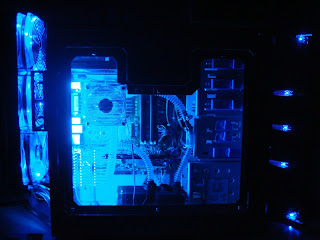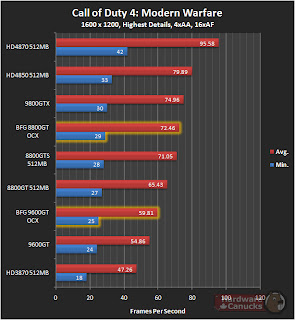For more than a year i had some liquid cooling stuff lying around. It was a customized purchase meant for use with my old Asus Striker Extreme for building an XTREME rig..... But then the introduction of Intel's 45nm processors and even 65nm quads demonstrated there severe incompatibility with Striker Extreme and other nvidia 680i chipset boards, especially in terms of overclocking. This overclocking failure (even to a mid level) shattered all my dreams of building an extreme rig. I still remember that in early days of 65nm Core 2 Dous, Striker Extreme ocing capability for those processors was nothing but outstanding but then it failed miserably to produce the same results for quad cores and 45nm processors. Several bios fixes from Asus couldn't even resolved the problem. Pretty much dishearten i sold that so called extreme board and gave up the idea of liquid cooling any more for few reasons, one among those i just explained. For other reasons, follow the post till the end :)
For the last few days i was thinking about using all that liquid cooling stuff that has been stored in boxes for nothing. It was quite an investment going to waste. Learned from my past experience, this time i decided to grab a budget board along with a budget processor. I already had an Asus P5K-VM, so i chose E5200 as my budget processor and started my journey to get max clock possible.
Following is a small description of all the components i used for my cheap XTREME PC
INTEL E5200 2.5GHz
ASUS P5K-VM G33 MOTHERBOARD
CORSAIR XMS2 2X512MB-667MHz RAM
BFG 9800GT 512MB OC+ GPU
SEAGATE 160GB SATAII HDD
COOLER MASTER EXTREME 500W PSU
RAIDMAX SMILODON CASING
Dtek FuZion Extreme *Performance CPU Block *with High Flow KIT
TYGON R3603 TUBING 3/8" ID-1/2"OD.
Swiftech COOL SLEEVES 625 HORIZON UV BLUE
Swiftech MCB-120 RADBOX
HARDWARE LABS 360(TRIPLE) STEALTH EXTREME RADIATOR
FLUID XP+ NON-CONDUCTIVE COOLANT (BLUE)
THERMALTAKE 3X120MM LED FANS-78CFM EACH
ASETEK WATERCHILL XTREME 12v PUMP WITH SOFTWARE CONTROL(Qmax 1020L/H)
MICRO COOL MOSFETS HEAT SINKS
LOGISYS CCFL TUBES-UV BLUE
From all the above mentioned stuff the only thing missing was the processor so i quickly grabbed one from the store to start building my new rig and after a lot of hard work i managed to build a good rig with pretty decent results.
Following are some overclocking details and screen shots from of my cheap XTREME PC (NOW YOU MUST HAVE GUESSED WHY I CALL IT CHEAP )
E5200 @ 4.0Ghz [320*12.5] / 1GB DDR2-667 @ 641Mhz - Dual Channel




I guess i wasn't lucky enough and got this E5200 with a significant higher VID of 1.225V. It is my guess that the fresh batch of E5200 would have lower VIDs. Try to look for the box with most recent packaging date if you are out for buying a processor. The one i purchased had a packaging date of Aug 08. Higher VID translates to higher heat out put and requires more higher Vcores for stable overclocking thus making it difficult to achieve max overclocks due to high heat out put by the processor and also heavily stressing the motherboard components responsible for supplying Vcore.
Having a CPU multiplier of 12.5, installing a NB liquid chipset cooler wasn't looking necessary as higher FSBs were not required. (Unless you want to lower your CPU multiplier for higher memory bandwidth).
Overclocking to 4.0GHz wasn't easy on this board with perfect stability. I had no option but to supply a Vcore of 1.55V to keep my E5200 perfectly stable @ 4.0GHz and passing stability tests like OCCT and playing CRYSIS. Windows was able to boot at 1.5v and complete Hiper Pi and Wprime calculations but OCCT was crashing in less than a minute. Fortunately due to the Liquid Cooling set-up, the temps remained well under control as core temps stayed around 59C,58C (ROOM TEMP 25C). I also had to perform the VDROP/VDROOP mod to completely make the system stable as before applying the mod, E5200 was unable to pass OCCT @ 3.5GHz due to significant vdrop/vdroop.
Everything was done on an average motherboard that has only 3 phase power delivery system and not much ocing features like NB STRAP, NB VOLT MANAGEMENT, LARGE VCORE INCREMENTS, LOWER MAX VALUE FOR VCORE AND VDIMM etc. I am very much convinced that at any high end board xtreme ocing will be pretty much easy. Do like to mention that i used additional mosfet heat sinks to keep the CPU surrounding area cool, especially under load.
At the end all the hard work got paid by achieving 60% or 1500MHz overclock and even the liquid cooling components found there use as well
Now for those of you out there that don't have any Liquid Cooling stuff and are planning to grab some for their future build, here are my suggestions regarding water or liquid cooling:
With next generation CPUs running cooler than ever before, like 45nm chips going at 4GHz+, water cooling is looking less and less attractive....at least for CPUs. Heat pipes air cooler have also taken the air cooling to the next level where the performance difference between air and water cooling is becoming less significant. Heat pipes have extremely high thermal conductivity and can distribute heat as well as water cooling. The benefits of heat-pipe cooling are two-fold. Not only is the processor cooled with a liquid which undergoes phase-change, it's still reaping the benefits of the thin-fin copper cooler. It's actually an amalgamation of water-cooling, phase-change, and air-cooling. You'll need to decide what you want from your system. If you want to do some extreme overclocking, then yes it is better. If you want a near silent cooling solution, yes its better but if you want a quieter system and want to do some minor to high end overclocking, there are cheaper options available. A good CPU air cooler can be quiet and cool very well. A couple of well placed 120mm fans will do wonders for airflow in your case and will only cost few hundred rupees. Even water-cooled systems need good airflow in the case.
Last but not least if you want to have fun and that shock and awe factor then there is nothing better than Liquid cooling......BUT according to Anandtech, you must spend at least $300 on a WC kit to outperform the best air-cooling. Some people might argue that $200 can beat any air cooling with a custom loop. Either way, a good WC system will only give you 0.2GHz or 0.3GHz more OC potential over air-cooling at a cost 3 times more than any high end air cooling. Now the choice is yours!



















